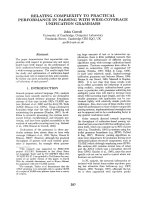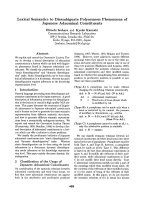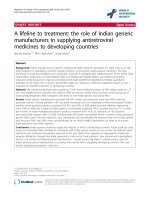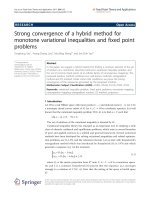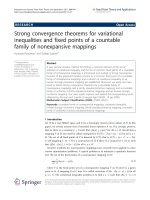Báo cáo hóa học: "STRONG CONVERGENCE TO COMMON FIXED POINTS OF NONEXPANSIVE MAPPINGS WITHOUT COMMUTATIVITY ASSUMPTION" pptx
Bạn đang xem bản rút gọn của tài liệu. Xem và tải ngay bản đầy đủ của tài liệu tại đây (481.22 KB, 8 trang )
STRONG CONVERGENCE TO COMMON FIXED
POINTS OF NONEXPANSIVE MAPPINGS WITHOUT
COMMUTATIVITY ASSUMPTION
YONGHONG YAO, RUDONG CHEN, AND HAIYUN ZHOU
Received 11 June 2006; Revised 27 July 2006; Acce pted 2 August 2006
We introduce an iteration scheme for nonexpansive mappings in a Hilbert space and
prove that the iteration converges strongly to common fi xed points of the mappings with-
out commutativity assumption.
Copyright © 2006 Yonghong Yao et al. This is an open access article distributed under
the Creative Commons Attribution License, which permits unrestricted use, distribution,
and reproduction in any medium, provided the original work is properly cited.
1. Introduction
Let H be a real Hilbert space, and let C be a nonempty closed convex subset of H.A
mapping T of C into itself is said to be nonexpansive if
Tx− Ty≤x − y, (1.1)
for each x, y
∈ C.ForamappingT of C into itself, we denote by F(T) the set of fixed
points of T. We also denote by
N and R
+
the set of positive integers and nonnegative real
numbers, respectively.
Baillon [1] proved the first nonlinear ergodic theorem. Let C be a nonempty bounded
convex closed subset of a Hilbert space H and let T be a nonexpansive mapping of C into
itself. Then, for an arbitrary x
∈ C, {(1/(n +1))
n
i
=0
T
i
x}
∞
n=0
converges weakly to a fixed
point of T.Wittmann[9] studied the following iteration scheme, which has first been
considered by Halpern [3]:
x
0
= x ∈ C,
x
n+1
= α
n+1
x +
1 − α
n+1
Tx
n
, n ≥ 0,
(1.2)
where a sequence
{α
n
} in [0,1] is chosen so that lim
n→∞
α
n
= 0,
∞
n=1
α
n
=∞,and
∞
n=1
|α
n+1
− α
n
| < ∞; see also Reich [7]. Wittmann proved that for any x ∈ C, the sequence
Hindawi Publishing Corporation
Fixed Point Theory and Applications
Volume 2006, Article ID 89470, Pages 1–8
DOI 10.1155/FPTA/2006/89470
2 Nonexpansive mappings w ithout commutativity assumption
{x
n
} defined by (1.2) converges strongly to the unique element Px ∈ F(T), where P is the
metric projection of H onto F(T).
Recall that two mapping s S and T of H into itself are called commutative if
ST
= TS, (1.3)
for all x, y
∈ H.
Recently, Shimizu and Takahashi [8] have first considered an iteration scheme for two
commutative nonexpansive mappings S and T and proved that the iterations converge
strongly to a common fixed point of S and T. They obtained the following result.
Theorem 1.1 (see [8]). Let H be a Hilbert space, and let C be a nonempty closed convex
subset of H.LetS and T be nonexpansive mappings of C into itself such that ST
= TS and
F(S)
F(T) is nonempty. Suppose that {α
n
}
∞
n=0
⊆ [0, 1] satisfies
(i) lim
n→∞
α
n
= 0 ,and
(ii)
∞
n=0
α
n
=∞.
Then, for an arbitrary x
∈ C,thesequence{x
n
}
∞
n=0
generated by x
0
= x and
x
n+1
= α
n
x +
1 − α
n
2
(n +1)(n +2)
n
k=0
i+ j=k
S
i
T
j
x
n
, n ≥ 0, (1.4)
converges strongly to a common fixed point Px of S and T,whereP is the metric projection
of H onto F(S)
F(T).
Remark 1.2. At this point, we note that the authors have imposed the commutativity on
the mappings S and T. But there are many mappings, that do not satisfy ST
= TS.For
example, if X
= [−1/2,1/2], and S and T of X into itself are defined by
S
= x
2
, T = sinx, (1.5)
then ST
= sin
2
x,whereasTS = sinx
2
.
In this paper, we deal with the strong convergence to common fixed points of two
nonexpansive mappings in a Hilbert space. We consider an iteration scheme for non-
expansive mappings without commutativity assumption and prove that the iterations
converge strongly to a common fixed point of the mappings T
i
, i = 1,2.
2. Preliminaries
Let C be a closed convex subset of a Hilber t space H and let S and T be nonexpansive
mappings of C into itself. Then we consider the iteration scheme
x
0
= x ∈ C,
x
n+1
= α
n
x +
1 − α
n
2
(n +1)(n +2)
n
k=0
i+ j=k
S
i
T
j
y
n
,
y
n
= β
n
x
n
+
1 − β
n
2
(n +1)(n +2)
n
k=0
i+ j=k
T
i
S
j
x
n
, n ≥ 0,
(2.1)
Yonghong Yao et al. 3
where
{α
n
} and {β
n
} are two sequences in [0,1]. We know that a Hilbert space H satisfies
Opial’s condition [6], that is, if a sequence
{x
n
} in H converges weakly to an element y of
H and y
= z,then
liminf
n→∞
x
n
− y
< liminf
n→∞
x
n
− z
. (2.2)
In what follows, we will use P
C
to denote the metric projection from H onto C; that is,
for each x
∈ H, P
C
is the only point in C with the property
x − P
C
x
=
min
u∈C
u − x. (2.3)
It is known that P
C
is nonexpansive and characterized by the following inequality: given
x
∈ H and v ∈ H,thenv = P
C
x if and only if
x − v,v − y≥0, y ∈ C. (2.4)
Now, we introduce several lemmas for our main result in this paper. The first lemma
can be found in [4, 5, 10].
Lemma 2.1. Assume
{a
n
} is a sequence of nonnegative real numbers such that
a
n+1
≤
1 − γ
n
a
n
+ δ
n
, (2.5)
where
{γ
n
} isasequencein(0, 1) and {δ
n
} isasequencesuchthat
(1)
∞
n=1
γ
n
=∞;
(2) limsup
n→∞
δ
n
/γ
n
≤ 0 or
∞
n=1
|δ
n
| < ∞.
Then lim
n→∞
a
n
= 0.
Lemma 2.2. Let C be a nonempty bounded clos ed convex subset of a Hilbert H,andletS, T
be nonexpansive mappings of C into itself. For x
∈ C and n ∈ N ∪{0},put
G
n
(x) =
2
(n +1)(n +2)
n
k=0
i+ j=k
S
i
T
j
x,
G
n
(x) =
2
(n +1)(n +2)
n
k=0
i+ j=k
T
i
S
j
x.
(2.6)
Then
lim
n →∞
sup
x∈C
G
n
(x) − SG
n
(x)
=
0,
lim
n →∞
sup
x∈C
G
n
(x) − TG
n
(x)
=
0.
(2.7)
4 Nonexpansive mappings w ithout commutativity assumption
Proof. We first prove lim
n→∞
sup
x∈C
G
n
(x) − SG
n
(x)=0.
By an idea in [2], for
{x
i, j
}
∞
i, j=0
, {x
i, j
}
∞
i, j=0
⊆ C and z
n
= (1/l
n
)
n
k
=0
i+ j=k
x
i, j
, z
n
=
(1/l
n
)
n
k
=0
i+ j=k
x
i, j
∈ C,withl
n
= ( n +1)(n +2)/2, we have
z
n
− v
2
=
1
l
n
n
k=0
i+ j=k
x
i, j
− v
2
−
1
l
n
n
k=0
i+ j=k
x
i, j
− z
n
2
(2.8)
for each v
∈ H.Forx ∈ C,putx
i, j
= S
i
T
j
x, x
i, j
= T
i
S
j
x and v = Sz
n
,v = Tz
n
.Then,we
have
G
n
(x) − SG
n
(x)
2
=
1
l
n
n
k=0
i+ j=k
S
i
T
j
x − Sz
n
2
−
1
l
n
n
k=0
i+ j=k
S
i
T
j
x − z
n
2
=
1
l
n
n
k=0
T
k
x − Sz
n
2
+
1
l
n
n
k=1
i+ j=k, i≥1
S
i
T
j
x − Sz
n
2
−
1
l
n
n
k=0
i+ j=k
S
i
T
j
x − z
n
2
≤
1
l
n
n
k=0
T
k
x − Sz
n
2
+
1
l
n
n
k=1
i+ j=k, i≥1
S
i−1
T
j
x − z
n
2
−
1
l
n
n
k=0
i+ j=k
S
i
T
j
x − z
n
2
=
1
l
n
n
k=0
T
k
x − Sz
n
2
+
1
l
n
n
−1
k=0
i+ j=k
S
i
T
j
x − z
n
2
−
1
l
n
n
k=0
i+ j=k
S
i
T
j
x − z
n
2
=
1
l
n
n
k=0
T
k
x − Sz
n
2
−
1
l
n
i+ j=n
S
i
T
j
x − z
n
2
≤
1
l
n
n
k=0
T
k
x − Sz
n
2
≤
2
n +2
diam(C)
2
,
(2.9)
where diam(C)isthediameterofC.So,wehave,foreachn
∈ N ∪{0},
sup
x∈C
G
n
(x) − SG
n
(x)
2
≤
2
n +2
diam(C)
2
, (2.10)
and hence
lim
n →∞
sup
x∈C
G
n
(x) − SG
n
(x)
=
0. (2.11)
Yonghong Yao et al. 5
Similarly, we have
lim
n →∞
sup
x∈C
G
n
(x) − TG
n
(x)
=
0. (2.12)
3. Convergence theorem
Now we can prove a strong convergence theorem in a Hilbert space.
Theorem 3.1. Let H be a Hilbert space, and let C be a nonempty closed convex subset of H.
Let S and T be nonexpansive mappings of C into itself such that F(S)
F(T) is nonempty.
Suppose that
{α
n
}
∞
n=0
and {β
n
}
∞
n=1
are two sequences in [0,1] satisfying the following condi-
tions:
(i) lim
n→∞
α
n
= 0 ,and
(ii)
∞
n=0
α
n
=∞.
For an arbitrary x
∈ C,thesequence{x
n
}
∞
n=0
is generated by x
0
= x and
x
n+1
= α
n
x +
1 − α
n
2
(n +1)(n +2)
n
k=0
i+ j=k
S
i
T
j
y
n
,
y
n
= β
n
x
n
+
1 − β
n
2
(n +1)(n +2)
n
k=0
i+ j=k
T
i
S
j
x
n
, n ≥ 0.
(3.1)
Let
z
n
=
2
(n +1)(n +2)
n
k=0
i+ j=k
S
i
T
j
y
n
, z
n
=
2
(n +1)(n +2)
n
k=0
i+ j=k
T
i
S
j
x
n
, (3.2)
for each n
∈ N ∪{0}. If there exist subsequences {z
n
i
}
∞
i=0
of {z
n
}
∞
n=0
and {z
n
j
}
∞
j=0
of {z
n
}
∞
n=0
,
respectively, which converge weakly to some common point z in some bounded subset D of C,
then the sequence
{x
n
}
∞
n=0
defined by (3.1)convergesstronglytoP
F(S)∩F(T)
x.
Proof. Let x
∈ C and w ∈ F(S)
F(T). Putting r =x − w, then the set
D
=
y ∈ H : y − w≤r
∩
C (3.3)
is a nonempty bounded closed convex subset of C which is S-andT-invariant and con-
tains x
0
= x. So we may assume, without loss of generality, that S and T are the mappings
of D into itself. Since P is the metric projection of H onto F(S)
∩ F(T), we have
y − Px,x − Px≤0 (3.4)
for each y
∈ F(S)
F(T).
6 Nonexpansive mappings w ithout commutativity assumption
From (3.4), we have
limsup
n→∞
z
n
− Px,x − Px
≤
0, limsup
n→∞
z
n
− Px,x − Px
≤
0. (3.5)
In fact, assume that, there exist two positive real numbers r
0
and r
1
such that
limsup
n→∞
z
n
− Px,x − Px
>r
0
,limsup
n→∞
z
n
− Px,x − Px
>r
1
. (3.6)
Since
{z
n
}
∞
n=0
and {z
n
}
∞
n=0
⊆ D are bounded, from (3.6), there exist subsequences
{z
n
i
}
∞
i=0
of {z
n
}
∞
n=0
and {z
n
j
}
∞
j=0
of {z
n
}
∞
n=0
, respectively, such that
limsup
n→∞
z
n
− Px,x − Px
=
lim
i→∞
z
n
i
− Px,x − Px
>r
0
,
limsup
n→∞
z
n
− Px,x − Px
=
lim
j→∞
z
n
j
− Px,x − Px
>r
1
.
(3.7)
By the assumption, we know that
{z
n
i
}
∞
i=0
and {z
n
j
}
∞
j=0
converge weakly to some com-
mon point z
∈ D.ThusfromLemma 2.2 and Opial’s condition, we have z ∈ F(S)
F(T).
In fact, if z
= Sz,wehave
liminf
i→∞
z
n
i
− z
< liminf
i→∞
z
n
i
− Sz
≤
liminf
i→∞
z
n
i
− Sz
n
i
+
Sz
n
i
− Sz
≤
liminf
i→∞
z
n
i
− z
.
(3.8)
This is a contradiction. Therefore, we have z
= Sz.
Similarly, we have z
= Tz.So,wehave
z − Px,x − Px≤0. (3.9)
On the other hand, since
{z
n
i
} converges weakly to z,weobtain
z − Px,x − Px≥r
0
. (3.10)
This is a contradiction. Hence, we have
limsup
n→∞
z
n
− Px,x − Px
≤
0, limsup
n→∞
z
n
− Px,x − Px
≤
0. (3.11)
Yonghong Yao et al. 7
Since
z
n
− Px
≤
2
(n +1)(n +2)
n
k=0
i+ j=k
T
i
S
j
x
n
− Px
2
≤
2
(n +1)(n +2)
n
k=0
i+ j=k
x
n
− Px
2
=
x
n
− Px
2
,
y
n
− Px
2
=
β
n
x
n
+
1 − β
n
z
n
− Px
2
=
β
n
x
n
− Px
+
1 − β
n
z
n
− Px
2
= β
2
n
x
n
− Px
2
+2β
n
1 − β
n
x
n
− Px,z
n
− Px
+
1 − β
n
2
z
n
− Px
2
≤ β
2
n
x
n
− Px
2
+2β
n
1 − β
n
x
n
− Px
2
+
z
n
− Px
2
2
+
1 − β
n
2
z
n
− Px
2
≤
x
n
− Px
2
.
(3.12)
Then, we have
x
n+1
− Px
2
=
α
n
x +
1 − α
n
z
n
− Px
2
= α
2
n
x − Px
2
+
1 − α
n
2
z
n
− Px
2
+2α
n
1 − α
n
z
n
− Px,x − Px
≤
1 − α
n
2
2
(n +1)(n +2)
n
k=0
i+ j=k
S
i
T
j
y
n
− Px
2
+ α
2
n
x − Px
2
+2α
n
1 − α
n
z
n
− Px,x − Px
≤
1 − α
n
2
2
(n +1)(n +2)
n
k=0
i+ j=k
y
n
− Px
2
+ α
2
n
x − Px
2
+2α
n
1 − α
n
z
n
− Px,x − Px
=
1 − α
n
2
y
n
− Px
2
+ α
2
n
x − Px
2
+2α
n
1 − α
n
z
n
− Px,x − Px
≤
1 − α
n
x
n
− Px
2
+ α
n
α
n
x − Px
2
+2
1 − α
n
z
n
− Px,x − Px
.
(3.13)
Putting a
n
=x
n
− Px
2
,from(3.13), we have
a
n+1
≤
1 − α
n
a
n
+ δ
n
, (3.14)
where δ
n
= α
n
{α
n
x − Px
2
+2(1− α
n
)z
n
− Px, x − Px}.
8 Nonexpansive mappings w ithout commutativity assumption
It is easily seen that
limsup
n→∞
δ
n
/α
n
= lim sup
n→∞
α
n
x − Px
2
+2
1 − α
n
z
n
− Px, x − Px
≤
0. (3.15)
Now applying Lemma 2.1 with (3.15)to(3.14) concludes that
x
n
−Px→0asn →∞.
This completes the proof.
References
[1] J B. Baillon, Un th
´
eor
`
eme de type ergodique pour les contractions non lin
´
eaires dans un espace de
Hilbert, Comptes Rendus de l’Acad
´
emie des Sciences de Paris, S
´
erie. A-B 280 (1975), no. 22,
A1511–A1514.
[2] H. Br
´
ezis and F. E. Browder, Nonlinear ergodic theorems, Bulletin of the American Mathematical
Society 82 (1976), no. 6, 959–961.
[3] B. Halpern, Fixed points of nonexpanding maps, Bulletin of the American Mathematical Society
73 (1967), 957–961.
[4] J.S.Jung,Viscosity approximation methods for a family of finite nonexpansive mappings in Banach
spaces, Nonlinear Analysis 64 (2006), no. 11, 2536–2552.
[5] P E. Maing
´
e, Viscosity methods for zeroes of accretive operators, Journal of Approximation Theory
140 (2006), no. 2, 127–140.
[6] Z. Opial, Weak convergence of the sequence of successive approximations for nonexpansive map-
pings, Bulletin of the American Mathematical Society 73 (1967), 591–597.
[7] S. Reich, Some problems and results in fixed point theory, Topological Methods in Nonlinear Func-
tional Analysis (Toronto, Ont., 1982), Contemp. Math., vol. 21, American Mathematical Society,
Rhode Island, 1983, pp. 179–187.
[8] T. Shimizu and W. Takahashi, Strong convergence to common fixed points of families of nonexpan-
sive mappings, Journal of Mathematical Analysis and Applications 211 (1997), no. 1, 71–83.
[9] R. Wittmann, Approximationoffixedpointsofnonexpansivemappings, Archiv der Mathematik
58 (1992), no. 5, 486–491.
[10] H K. Xu, Viscosity approximation methods for nonexpansive mappings, Journal of Mathematical
Analysis and Applications 298 (2004), no. 1, 279–291.
Yonghong Yao: Department of Mathematics, Tianjin Polytechnic University, Tianjin 300160, China
E-mail address:
Rudong Chen: Department of Mathematics, Tianjin Polytechnic University, Tianjin 300160, China
E-mail address:
Haiyun Zhou: Department of Mathematics, Shijiazhuang Mechanical Engineering College,
Shijiazhuang 050003, China
E-mail address:

